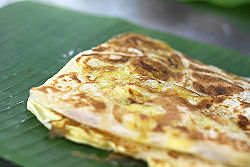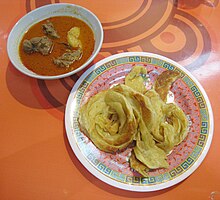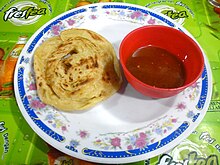Roti canai
This article needs additional citations for verification. (August 2007) |
 Roti canai | |
| Alternative names | Roti cane |
|---|---|
| Type | Flatbread |
| Place of origin | Malaysia[1] [2][3] |
| Region or state | Malaysia, Indonesia, Singapore |
| Created by | Indian Cuisine |
| Serving temperature | Hot |
| Main ingredients | Flour |
| Variations | Paratha |
Roti canai (pronunciation tʃanai) or roti cane (pronunciation tʃane) is a type of Indian-influenced flatbread found in Malaysia, Singapore and Indonesia. It is often sold in Mamak stalls in Malaysia; also in Malay, Minangkabau and Aceh restaurants in Indonesia. It is known as roti prata in Southern Malaysia and Singapore, and is similar to the Indian Kerala porotta.
Origin of the word
Roti means bread in Hindi, Urdu, most other North Indian languages, and Malay. The term "canai" derives either from:
- Chennai, a city in India which is more popularly known by its colonial name Madras. Roti canai is presumed to have been introduced by immigrant labour from the Madras region where a similar combination of parotta and dalcha - the accompanying lentil curry - is served.[4]
- Channa, a dish made with boiled chickpeas in a spicy gravy from Northern India with which this type of bread was traditionally served.[citation needed] However, the roti in Northern India is different from that served in Malaysia, and roti canai is often served with dhal or lentil curry rather than chickepea curry.[citation needed] The latter is more similar to the South Indian parotta.[citation needed]
- The Malay word "canai", which means "to roll out dough".[citation needed]
Roti canai is circular and flat. There are two ways to make roti canai that is either to twirl it until the dough becomes a very thin sheet and then folded into a circular shape or to spread out the dough as thinly as possible before being folded. Then the folded dough is grilled with oil. The first method is more popular and faster than the second. The term 'roti paratha' in Malay means 'plate bread'.

In Indonesia, roti canai is often spelled as "roti cane", and usually served with Kari Kambing (mutton curry).[5] It is derived from Indian cuisine and came into Indonesia via the influx of Muslim Indian migration to Aceh Sultanate in Northern parts of Sumatra circa 17th century, and later to the rest of Dutch East Indies in early 19th century.[5] Roti canai is more prevalent in Sumatra, especially in Aceh, North and West Sumatra. Roti cane has been adopted within Malay cuisine of Sumatra, Aceh cuisine, and Minangkabau cuisine. Consequently, there are Malay, Aceh, and Minangkabau restaurants that serve roti canai with mutton curry in Indonesia that are operated by ethnic groups other than Indians. This Indian-origin dish has been well-integrated into Aceh cuisine that it has been considered as theirs.[5]
In English and in Chinese, roti canai is sometimes referred to as "flying bread" (飞饼 fēibǐng), a term that evokes the process of tossing and spinning by which it is made. In Chinese, Roti Canai is originally called 印度煎饼 "yin du jian bing", which means Indian Fried Biscuit (Bread).
The roti canai dish
Composition
The dish is composed of dough containing copious amounts of fat, flour and water. The form of fat used is usually ghee (clarified butter). Some people add sweetened condensed milk to the mix. The entire mixture is kneaded thoroughly, flattened, oiled and folded repeatedly. It is then allowed to proof and rise, and the process is repeated. The final round of preparation consists of flattening the dough ball, coating it with oil and then cooking on a flat iron skillet with a lot of oil. The ideal roti is flat, fluffy on the inside but crispy and flaky on the outside.
Consumption

The examples and perspective in this article may not represent a worldwide view of the subject. (December 2010) |
One of the characteristics of roti canai and its derivatives is that it can be eaten with the hands, without the need for utensils. This makes it a convenient dish to consume, while being filling. This characteristic makes it a dish of choice as breakfast or as late night supper.
Traditionally, it is served with dal or 'dhal' (lentil) curry, which in North India is prepared with chana dal. It can sometimes be taken with sugar or condensed milk, or sambal tumis. More recently, various improvements on plain roti have been devised to suit Malaysians. Generally the newer forms of roti canai are denoted by prefixing roti to the additional ingredient used. Common variations include:
- Roti telur, with fried eggs (telur being the Malay word for egg)
- Roti tisu (tissue bread), a paper-thin and flaky roti. Also called roomali roti, from roomal (Hindi, meaning handkerchief).
- Roti bawang (onion bread)
- Roti boom (bomb bread), a smaller but thicker roti, usually round in shape.
- Roti planta, stuffed with margarine (often Planta Margarine) and sugar.
- Roti sardin, stuffed with sardine and sometimes mixed with ketchup or sambal, similar to murtabak
- Roti pisang, banana bread
- Roti badut, Clown bread stuffed with M&M's, red and blue icing to resemble the face of a clown. Usually consumed by kids.
- Roti tofu, Vegetarian version stuffed with tofu and sometimes with added onions.
- Roti sayur, Another vegetarian version where different kinds of vegetables (usually spinach) are stuffed inside the roti.
- Roti durian, Stuffed with durian for durian lovers.
- Roti beer, The dough is usually marinated in beer for a distinct beer flavour.
Some consumers may also order their own variation, such as:
- Roti telur bawang, with eggs (telur) and onions (bawang)
- Roti kaya, with kaya
- Roti tampal, similar to roti telur but the eggs are stuck on the outside instead
- Roti tuna, stuffed with tuna
- Roti cheese, with cheese added
- Roti milo, although not common, some consumer requested that the roti is sprinkled with Milo powder
- Roti babi, stuffed with pork.
- Roti kacang, cooked with lentils or beans
- Roti ayam, cooked with chicken stock
- Roti A&W, replaces shortening with A&W root beer. The result is carbonated and fluffy but not crispy rotis.
- Roti kopi, served with shredded coffee beans.

There are also a lot of different curries used besides dhal, for example:
- Kari ayam, chicken curry
- Kari daging, beef curry
- Kari kambing, mutton curry
- Kari ikan, fish curry (mostly served with stingray)
- Kari campur, mixed curry (consumers can select a mixture of dhals themselves)
- Kari dhal, dhal curry cooked usually using Australia dhal with potato, lentils, etc...[clarify]
Most plain roti are round, while those with fillings are square in shape due to the folding of the roti. Due to time saving concerns, the maker usually has a "stock-ready" bucket that keeps pre-made roti. These rotis are usually round in shape and will eventually become cold. Therefore, consumers might insist on a square roti to ensure they get a freshly prepared one.
Roti canai is affordable[clarify] in Malaysia[citation needed] (the standard price is RM0.90 a piece in Malaysia),[citation needed] making it extremely popular there. It is also available in frozen form whereby pre-fried roti canai is processed through a blast-freezing technique to ensure a soft and fluffy texture upon defrosting and refrying.
Some hawkers serve fluffy and crispy roti canais by placing fried roti canai on a flat surface and giving them a soft clap with both hands.[citation needed][clarification needed]
Preparation of roti canai in pictures
-
The mixture is kneaded, flattened, and then oiled, before being folded repeatedly.
-
Roti canai is cooked on a flat iron skillet with a lot of oil.
-
Another picture of Roti Canai making.
-
A sweet Thai roti kluai khai: similar to roti canai, it is folded around a filling of sliced bananas and egg
-
Roti thitchu (Thai for "tissue") is a version of Thai roti canai that is fluffed up by clapping it between two hands inside a dry cloth after frying. Here it is served with a Thai-Muslim style beef curry.
See also
- Mamak stall
- Paratha
- Goat roti
- Kerala Porotta
- Roti prata, the Singaporean variant.
References
- ^ "Kuala Lumpur: Roti Canai".
- ^ "Roti Canai (Authentic Malaysian Recipe)".
- ^ "Adventurous Polish loves Kg Baru, roti canai and helps new expats get to know M'sia: Roti Canai".
- ^ Jaffrey, Madhur (2003). Madhur Jaffrey's Curry Bible. Ebury Press. pp. 283–4. ISBN 0-09-187415-7.
- ^ a b c Cite error: The named reference
Kompaswas invoked but never defined (see the help page).
External links






